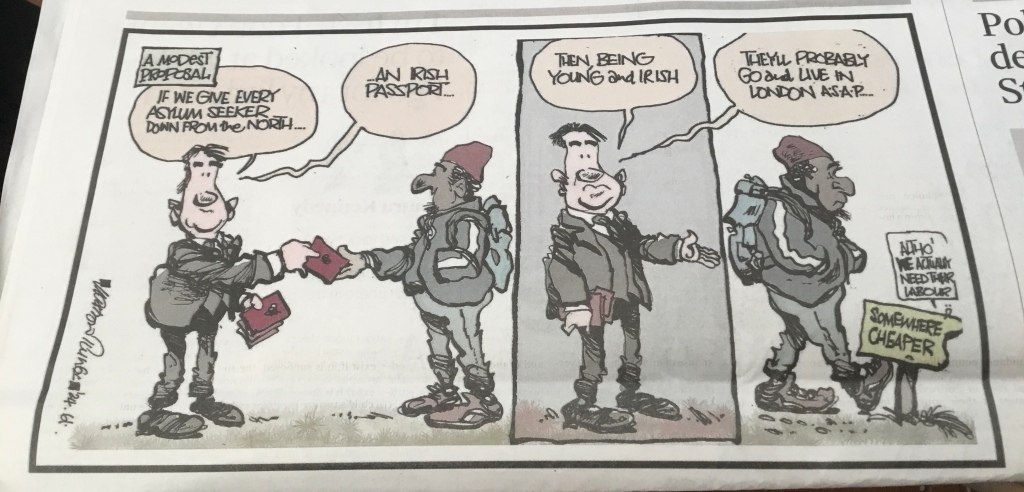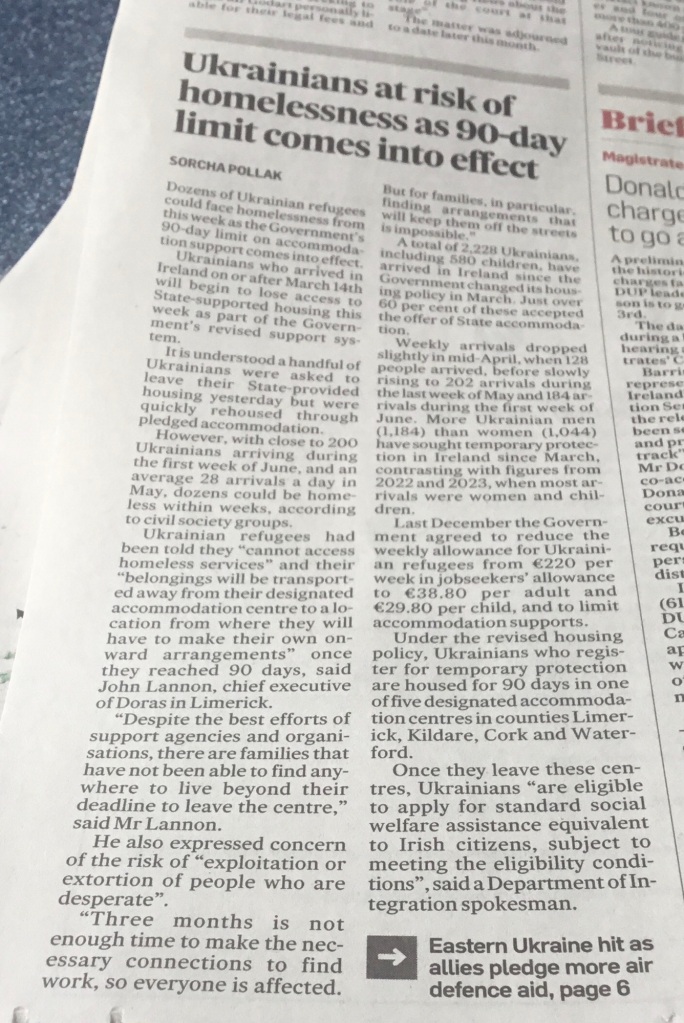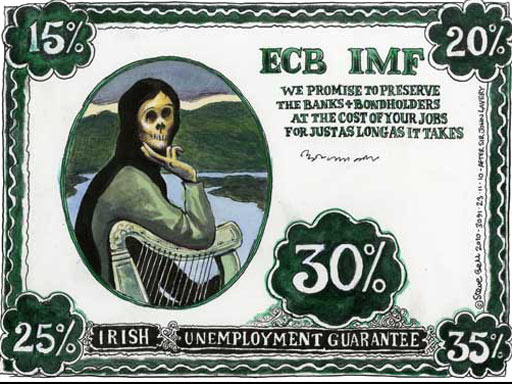“Sinn Féin’s disaster was the standout story of the weekend’s count” – Cedar Lounge Revolution Blog starts important discussion
Overall, the June 7 2024 Local and European elections in the 26 County bit of Ireland were good news for the ruling coalition elected in February 2020. The Fianna Fáil-Fine Gael-Greens plus Gombeens (FFFGGG) combination scored an important victory, setting them up for a possible return to the seat of government in Dublin’s Leinster House in less than 12 months, when a new general election must happen.
Even worse, due to ominous rising support for Gombeen currents (primarily the Independent Ireland [II]) party and extreme racists, FFFG might be able to dump the Greens and rule on their own – or coalesce with the II gombeens and other toxic racist-right populists.
This new political landscape can be navigated by the fighting and anti-racist left. However. a proposed “left government” led by Sinn Féin looks like an impractical mirage. In the last few months the Sinn Féin party has pandered to rising racist activity, offering the vile dog-whistle : SF opposed to Open Borders.

SF advertised support for savage government cuts in support for Ukrainian refugees : the grim results are told in this Irish Times story (June 13 2024)

This tactic lit a fire 🔥 which helped to create an electoral disaster for the party. Opinion polls tracked falling Sinn Féin support for several months – but the party’s performance in these elections was much worse than predicted.
The Cedar Lounge Revolution Blog editor, WorldByStorm, offers a very good and honest concrete analysis, which could begin a useful practical discussion on the way forward for the fighting left in Ireland
Link : https://cedarlounge.wordpress.com/2024/06/13/that-sinn-fein-collapse/
John Meehan, June 13 2024
Pat Leahy isn’t entirely wrong in the following:
Sinn Féin’s disaster was the standout story of the weekend’s count. Opinion polls in recent months have tracked a steady decline in support for the party. But with recent general election polls putting the party in the 20s, the actual result that took shape when the ballot boxes were opened was far worse than party figures anticipated, even in their worst-case scenarios.
At less than 12 per cent for the local elections, the result shows a collapse in Sinn Féin support that is of a magnitude that will be hard to reverse before a general election. Counts today in the European elections could bring more bad news, with a possibility that the party could be without a seat in any – or, unbelievably, all – the European Parliament constituencies. That’s unlikely, but Sinn Féiners will be living on their nerves today.
That said, Fianna Fáil and Fine Gael haven’t done terribly well either. They too have losses.
Still, he’s got a point here:
Is it true that Sinn Féin had a terrible local and Euros in 2019, and turned that around within eight months to have a barnstorming general election in February 2020. Hard trick to repeat, though. And they might not get eight months this time. Party leader Mary Lou McDonald, who faced the music in the RDS yesterday with defiance, faces the hardest challenge of her political career.
And broadly speaking he seems correct here:
Sinn Féin’s collapse opened the space for a surge in support for Independents, who made gains across the country.
Looking back across the last three years one has to wonder if the very high Sinn Féin vote in polls was always something of a chimera. People often point to the pandemic as one of the reasons why the far-right gained some momentum. But could it be that the pandemic also exaggerated Sinn Féin’s vote? Yet that’s not all of it. Sinn Fein went from 13.8% (oddly close to the local election results) in 2016 to 24.5% in 2020. So there was real momentum there for further gains.
We must factor in caveats. Local elections are not national elections. There are so many candidates and so many places for votes to go. Moreover the dynamics are radically different. General election polling has them up around 22%. Yet Sinn Féin could comfortably have expected to be polling well above 15%. To have dropped to or below 12% is a serious problem.
The problems of this vote are manyfold. There is a loss of morale. This isn’t a small thing. Those who have pounded the streets the last month and more have to reorient to the next election. There’s the perception amongst voters that Sinn Féin is weakened. That increases the morale of rivals – one can see that Fine Gael in particular can hardly contain its glee at the current difficulties encountered by Sinn Féin. But it also makes voters more sceptical and more open to voting for others. There’s the basic question as to what can be done to turn this around. I don’t know, does anyone?
What is telling is that Leahy doesn’t offer a reason why Sinn Féin has run into this trouble. Is this a leadership issue, a policy issue, something else? The structural reasons include running too many candidates. Way too many candidates. North Inner City was a perfect example. Three candidates of which just one made it (in fairness FF ran three of which not one came close to winning). For a party famed for its supposed acumen in elections management it seems very uncertain in local elections in the Republic. The IT offers an insight into other areas where SF ran ‘a hugely ambitious local election strategy’.
But one might reasonably ask what was this strategy based on? What if any polling was conducted to see if it was sufficiently robust to meet engagement with actual voters. Add to that oddly sporadic canvassing (Una Mullally noted that in the IT and I’d second that. Where I live which is in the heart of McDonald’s constituency it is the Fine Gael councillor who is by a country mile most active to judge from visits and so on. Next up a local community Cllr. Beyond that the GP and only after that SF). So what this a case of believing or seeming to believe overly optimistic polls? Or a rhetoric of SF as the leading party. I think it’s the RTÉ politics podcast that has a quote in its intro from McDonald where she claims that the old political model of two leading parties is shattered and over for good. I’m never keen on statements in politics that are so emphatic and certain, particularly when they point to another party, that of the speaker being the inevitable beneficiary. But if people in a party begin to believe it, that’s a problem as well. Just by the way, none of this is just off the top of my head – here’s a report with SF councillors interviewed who make many of the same points.
Beyond that there’s a hazier element. A sense of their being oddly unsure footed. It sounds almost absurd to say this, but what does Sinn Féin stand for? We say they are on the left but where? They’re extremely coy about that. But policy wise while clearly in favour of state activism in areas like housing there’s almost a sense that it’s not quite joined up. And while their dedication to unity is much more clearly stated, how that resonates in this particular polity is somewhat more contradictory than they or many of us might like to hope. It’s been noted in comments, the number of those who agree with SF’s analysis as regards, say, housing, but now believe the party won’t be in a position to change matters or even if it is won’t be able to. Add to the above is a problem for the party is that it’s oddly overfamiliar. There is a thought that somehow SF has felt almost part of the Leinster House institutions in some odd way. They’re not in government, of course, but they feel as if they’ve been in opposition so long that they’re somehow not quite oppositional. I’m not expressing that well, but it’s worth parsing out. As noted in comments their push towards the centre and their very curious inability to engage with the refugee issue perhaps adds to this.
I’d long been thinking Fianna Fáil was in dire straits. And yet looking at their cohort of 200+ councillors and that of Fine Gael with more again and then looking at Sinn Féin’s much lower level and I wonder if we are looking at FF, SF and FG floating around in much the same political space in terms of national representation. It is still very likely that SF will be well ahead of Fine Gael and Fianna Fáil. But it doesn’t seem to be connecting sufficiently at the local level.
A couple of further thoughts. Sinn Féin went into this election with considerable prominence. With the institutions reinstalled in the North that gave them an exposure other parties that would be delighted with. Yet it appears to have had no impact on voters whatsoever. Northern Ireland doesn’t seem to win votes for parties in the South.
Finally, and this is becoming something of a single transferable point made in posts this last while. The volatility of the electorate both giveth and taketh away and giveth. Perhaps no parties should be depending upon a base any longer. But how to try to capture sufficient to make breakthroughs? That’s a question.
Whatever else SF will have to consider all this, and where it is and where it is going – because it is one of the progressive elements in our politics. And it is going to have to do that quickly, with the increasing possibility of an election within the next four or five months.
Link, Local Government Results : https://www.rte.ie/news/elections-2024/results/#/local/national
Link, European Parliament Results : https://www.rte.ie/news/elections-2024/results/#/european/national

[…] Readers might also be interested in this article, which makes many similar points “Sinn Féin’s disaster was the standout story of the weekend’s count” –… […]
“5 Takeaways from the Elections” by Paul Murphy and Diarmaid Flood, Rupture Magazine | Tomás Ó Flatharta
Jun 14, 2024 at 4:27 pm